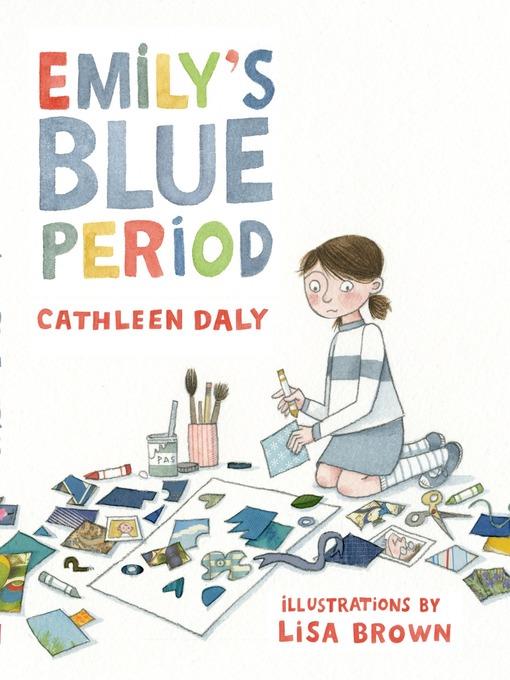
Emily's Blue Period
فرمت کتاب
ebook
تاریخ انتشار
2014
Lexile Score
540
Reading Level
0-2
ATOS
2.8
Interest Level
K-3(LG)
نویسنده
Lisa Brownناشر
Roaring Brook Pressشابک
9781466873155
کتاب های مرتبط
- اطلاعات
- نقد و بررسی
- دیدگاه کاربران
نقد و بررسی

March 31, 2014
Daly (Prudence Wants a Pet) offers a picture book with a middle-grade sensibility, examining the way that creating art can help dispel distress—in this case, the sadness that accompanies parental separation. Emily is already interested in art when her teacher introduces the class to Picasso: “Things in his paintings weren’t where you’d expect them to be.” When Emily’s father moves into his own apartment, things aren’t where Emily expects them to be, either. Holding a book about Picasso like a shield, she tells her mother why she can’t complete her art project: “I am in my blue period.” Brown (29 Myths on the Swinster Pharmacy) keeps her pencil and watercolor drawings simple and lucid, while Daly ably balances sentimentality and wit, as when Emily discovers Picasso’s long full name and renames herself “Emily Emilia Rosita Jenny... Igor de la Eyeball Montoya Fluffy Pinchner.” When Emily is able at last to make a collage about her home, Daly conveys believable affection without sinking into soppiness. Ages 4–7. Author’s agent: Meredith Kaffel, DeFiore and Company. Illustrator’s agent: Charlotte Sheedy, Charlotte Sheedy Literary Agency.

May 1, 2014
A girl adjusts to her parents' divorce with the help of Pablo Picasso's artwork.In school, Emily's learning how Picasso's cubist portrayals "mix things up," scooting a nose sideways or stacking eyes over eyes. This notion touches her, as her family feels mixed up too: "Emily's dad is no longer where he belongs. Suddenly, he lives in his own little cube." An aerial map shows Emily's gridlike neighborhood, her father's new building-pale blue-two blocks from the family house. At a furniture store, Emily sees the furniture as blue and blue-green cubes and refuses to help Dad choose any. She won't use black charcoal; like Picasso when he was sad, she hews to blue. Despite cuddles from Mom, "Emily's Blue Period lasts quite some time." A school assignment chafes: How can she make a collage of her house when she has two? Gathering objects from both, she figures it out, but textual pacing frustrates somewhat: Her completed "big and soggy and beautiful" chef-d'oeuvre is described in words for eight pages before it's shown, implying that her piece's concept outweighs its artistic value rather than complementing it. However, Brown's soothing, blue-focused watercolors with pencil lines and digitally collaged highlights provide an accessible visual link to Picasso. One out-of-place joke about Picasso's full Spanish name rankles.A worthwhile, idiosyncratic demonstration of a specific artist's relevance to a young child. (Picture book. 4-7)
COPYRIGHT(2014) Kirkus Reviews, ALL RIGHTS RESERVED.

Starred review from May 1, 2014
Gr 1-3-A lovely, contemplative picture book. The text is short, with no more than a few sentences per page, but the writing is evocative and does a wonderful job of portraying the complicated emotions and behaviors experienced by children during confusing times. Divided into five vignettes labeled as chapters, the story is that of Emily, a young girl who loves art-particularly Pablo Picasso's unique way of portraying the world through cubism. When her parents separate, both she and her younger brother struggle to cope with the new reality. This book does a beautiful job of using the arts to show Emily's process as she grieves, accepts, and adapts to the changes in her family. The pencil and watercolor illustrations are appropriately muted, sticking to a soft blue, green, and brown color scheme with highlights of yellow and red. The subtle addition of some digital imagery creates lively, relatable illustrations. Despite the difficulties that Emily's family may be having, their imperfect life is full of love, and that comes through in both art and text. This is not a straightforward "What is divorce" story but rather a window into one girl's complicated emotional journey. It's a first purchase for libraries that have a section of picture books for older readers, and a high-quality, nondidactic book for parents and caregivers looking to start conversations about divorce.-Anna Haase Krueger, Ramsey County Library, MN
Copyright 2014 School Library Journal, LLC Used with permission.

July 1, 2014
Grades K-3 Aspiring artist Emily is trying to make sense of her life, which right now is all in pieces, since her mom and dad don't live together any more. In school, she learns about Picasso and his different artistic styles. For instance, in his cubism period, faces and objects aren't where you'd expect them to be (neither is dadhe has moved out). Things are all mixed up, just the way Emily feels. So she enters her blue period, and it lasts quite a while. However, when her teacher presents collage in art class, Emily has an idea. She borrows and collects significant things, and cuts and glues them into a big, soggy, and beautiful collage, combining all she loves about her family and home into a heart-shaped picture. Artwork in the five brief chapters includes some clever examples mirroring Picasso's styles, and each scene shows details of Emily's character and her world. During the blue period, tones are gray and black and blue, but the final colorful collage invites children to find all the parts of Emily's life. Artful.(Reprinted with permission of Booklist, copyright 2014, American Library Association.)

























دیدگاه کاربران